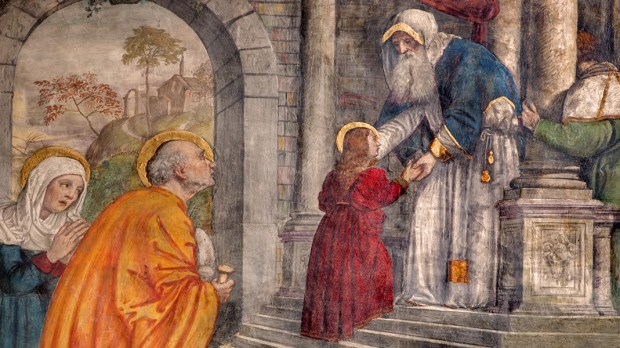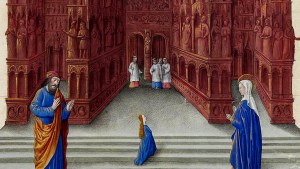The November 21 Feast of the Presentation of Mary changes the picture of Mary’s life most of us have, considerably.
The feast has been celebrated since the early days of Christianity, especially in the East. The Western Church has been less dedicated to the feast, and now we stress that this is the anniversary of Saint Mary’s church in Jerusalem rather than risk “celebrating something that never happened.”
But Doctor of the Church St. Alphonsus Ligouri delights in it and Michael Hesemann in 2011’s Mary of Nazareth suggest that key evidence supports the ancient tradition that Mary was Presented in the Temple by her parents as a child, to live there and be educated in her faith.
Imagining Mary’s story with this background changes our understanding of her — starting with the five Joyful Mysteries of the Rosary.
First, the Annunciation, and Mary’s relationship with Joseph, becomes clearer.
Think of each line from Luke’s account of the Annunciation with Mary’s Temple background in mind.
The angel Gabriel is sent “to a virgin betrothed to a man whose name was Joseph, of the house of David.” If Mary’s parents had presented her to live in the Temple when she was very young and they were very old, then the story of her betrothal is in large part a matter of Mary being provided for upon leaving the Temple.
The angel tells Mary that she will conceive and bear a son “and the Lord God will give him the throne of his father David.” A girl educated in the Temple, Mary would have known exactly what that means: She was to be the mother of the messiah.
Mary responds: “How can this be, since I am a virgin?” That response is strange for a woman betrothed to be married, but it makes much more sense if we know she has made a special commitment to celibacy — as someone presented in the Temple would have done — and if it is a commitment she intends to keep.
Mary says, “Behold, I am the handmaid of the Lord.” If she had lived in the Temple, then that phrase was literally true about her: She spent her childhood helping in the Lord’s house.
Second, the Visitation story makes a new kind of sense.
In the Gospel, after being told that she will be the mother of the Lord, the Blessed Mother is told that her cousin Elizabeth, the wife of Temple priest Zechariah, is pregnant. She goes in haste to help.
I always pictured this as a girl who has grown up helping around her house going to another house to help out. But her Temple background would make this the story of a helper who is uniquely suited for the role of serving a Temple priest’s household.
And a girl educated in the Temple would have had the rich knowledge of Scripture necessary to compose the Magnificat.
Even the Nativity of Jesus takes on a new dimension.
Bethlehem, just outside Jerusalem, was a city of sheep and shepherds, because many sheep needed to be provided for families participating in the Temple sacrifice. If Mary grew up in or near the Temple, she would have been well acquainted with the sights and sounds of animals and animal sacrifice. So it would have been especially poignant for Mary to travel so close to her childhood home to give birth among the animals and to be visited by shepherds.
After the crucifixion, the significance would not be lost on the Blessed Mother that the Lamb of God entered the world where so many sacrificial lambs had also been born. You see this aspect of the story emphasized in the Gospel written by John, who lived with her.
Of course, her Presentation would also lend more significance to the Presentation of Jesus in the Temple.
I have always thought of the moment when the holy man Simeon sees the baby Jesus as a miracle of recognition: Simeon knew Jesus at first sight. But if Mary spent her childhood at the Temple, it is not hard to imagine that he had seen her before.
In fact, pious legends speak of how her holiness was obvious to the Rabbis and helpers at the Temple. When Simeon sees the child, it is possible that he recognizes Christ’s significance in part because he already knows her significance — and that when he prophesies that a sword will pierce Mary’s heart, he may be sharing a prophecy he has had for a long time.
And we are explicitly told that Anna, who also praised the baby Jesus, had lived a long time in the Temple. If Mary had also, then surely Anna knew her — maybe very well.
But the most poignant connection of all is the Finding in the Temple.
When Joseph and Mary finally find the boy Jesus after having lost him for three days, he says “Did you not know I would be in my Father’s house?” If Mary had grown up in or near the Temple she would have personally known no other home than this as a child herself.
So instead of imagining that Jesus’ words simply meant, “God is my true Father. Of course I would be here!” We could maybe imagine they also mean: “This place is your home, too. Isn’t this where you would go?”
In the end, we can understand Mary’s special relationship with the Temple no matter where she grew up.
Mary is compared to the Ark of the Covenant, and she is the first and best example of the Christian understanding that “your body is a temple.”
Whether she lived there or not, she loved the Temple, and felt the full power of Psalm 24: “One thing I ask of the LORD; this I seek: To dwell in the LORD’s house all the days of my life, to gaze on the LORD’s beauty.”


